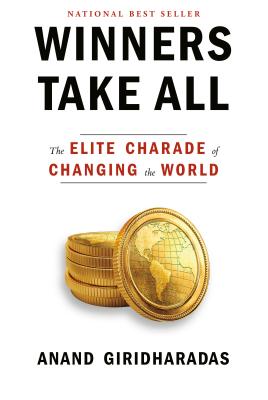Winners Take All: The Elite Charade of Changing the World
Anand Giridharadas

“There are a thousand hacking at the branches of evil to one who is striking at the root, and it may be that he who bestows the largest amount of time and money on the needy is doing the most by his mode of life to produce that misery which he strives in vain to relieve.” -Thoreau
I think the topic of this book is important, but I was disappointed by the book itself. I had listened to a couple of radio interviews with Anand Giridharadas and found him thoughtful and interesting. In those interviews, he told the story of how he came to write this book based on his own experience in the high-status “thought-leader” business-oriented philanthropic world. But unfortunately, in the book itself, this story is relegated to an afterword. Instead, the book seems to be mostly a popularization of scholarly work around the relationship between philanthropy and democracy–particularly the 2016 book “Philanthropy in Democratic Societies” edited by Reich, Cordelli, and Bernholz. This became apparent to me in the last section of AG’s book, which is just a recounting of some of Chiara Cordelli’s main views in interview format.
I think the actual subject matter of the book is pretty interesting. It’s more or less captured in the epigraph from Thoreau I gave above (which I found in Rob Reich’s 2018 book “Just Giving”): large-scale philanthropy today is (a) to a large degree funded by the profits of activities that cause harm to society, and (b) is oriented toward only those charitable activities that do not pose any threat to the ongoing making of said profits. (The fact that Thoreau also made this criticism should tell us that this is not exactly a new phenomenon!) My personal view is that a complex issue such as this one is better served by a more analytical treatment, which is why I picked up Reich’s book after reading this one. It’s ironic that AG criticizes the TED talk set for their “zoom-in” approach, which focuses on an individual story rather than zooming out to analyze the relevant structural forces, yet himself adopts that very technique in this book, which is structured as a series of chapters each focusing on some one person’s story!
This book appears to be very popular, and I guess it’s a good thing that it’s getting the concepts in front of a lot more people than I’m sure Reich’s book will. (I guess that is the point of popularizing books!) It’s just not a satisfying treatment for me.